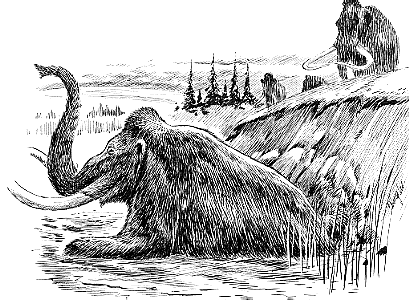
December 13, 2007

In Ivan T. Sanderson’s 1960 Saturday Evening Post article, “Riddle of the Frozen Giants,” he wrote of his catastrophic astronomical theory to explain the frozen mammoths and frozen wooly rhinos. Sanderson was laughed at for his thoughts. But was he right, after all?
Sanderson’s claims were frequently debunked because, among other items, mammoths were supposedly said to have rotten before they froze. But were some of his basics grounded, instead, in good data and logic?
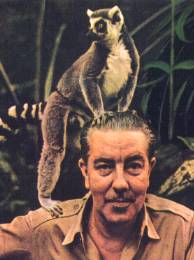
Ivan T. Sanderson (above), Charles Hapgood, and Immanuel Velikovsky may be on their way to finally being partially vindicated by a small research announcement, which casually slipped by you in the science news this week.
Did you hear what discovery over twenty scientists working as a team released at a meeting of the American Geophysical Union in San Francisco?

According to the BBC News: “Startling evidence has been found which shows mammoth and other great beasts from the last ice age were blasted with material that came from space. Eight tusks dating to some 35,000 years ago all show signs of having being peppered with meteorite fragments. The ancient remains come from Alaska, but researchers also have a Siberian bison skull with the same pockmarks.”
Wait a minute? Mammoths killed by debris from outer space? These remarkable new findings are confirming a major component of Sanderson’s theory: the mammoths were hit by debris from outer space!
“We think that there was probably an impact which exploded in the air that sent these particles flying into the animals,” said Richard Firestone from the Lawrence Berkeley National Laboratory. “In the case of the bison, we know that it survived the impact because there’s new bone growth around these marks.”
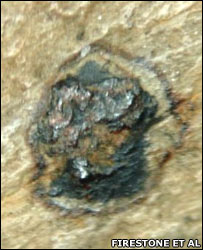
The mammoth and bison remains all display small (about 2-3mm in size) perforations. Raised, burnt surface rings trace the point of entry of high-velocity projectiles; and the punctures are on only one side, consistent with a blast coming from a single direction.
Viewed under an electron microscope, the embedded fragments appear to have exploded inside the tusk and bone, say the researchers. Shards have cut little channels.
The sunken pieces are also magnetic, and tests show them to have a high iron-nickel content, but to be depleted in titanium.
The ratios of different types of atoms in the fragments meant it was most unlikely they had originated on Earth, the team told the AGU meeting.
The discovery follows on from the group’s previous research which claimed a more recent space collision – some 13,000 years ago. The researchers reported the discovery of sediment at more than 20 sites across North America that contained exotic materials: tiny spheres of glass and carbon, ultra-small specks of diamond and amounts of the rare element iridium that were too high to be terrestrial. The scientists also found a black layer which, they argued, was the charcoal deposited by wildfires that swept the continent after the space object smashed into the Earth’s atmosphere. ~ Jonathan Amos, “Great beasts peppered from space,”, BBC News, December 12, 2007.

“We had found evidence of particle impacts in chert, or flint, at a Clovis Indian site in Michigan,” Dr Firestone said.
“So, we got the idea that if these impacts were in the chert, then they might likely also have occurred in large surfaces such as tusks; and we decided it was worth a shot to go look for them.”
Allen West began the hunt at a mammoth tusk sale in his home state of Arizona.
He immediately found one tusk with the tell-tale pockmarks and asked the trading company if he could look through its entire collection. He sorted literally thousands of items.“There are many things that can cause spots, such as algae, and there were a few of those; but I was only interested in the ones that were magnetic,” he recalled. “It was just a tiny magnet on a string, but very strong. It would swing over and stick firmly to these little dots.”
The search turned up a further seven ivory specimens of interest, together with the bison skull.But having gone out and tested the hypothesis of tusk impacts, and having apparently uncovered such items – the team was then astonished to find the animal remains were about 20,000 years older than had been anticipated. ~ Jonathan Amos, “Great beasts peppered from space,”, BBC News, December 12, 2007.
This will lead to further research and more looks at old tusks, that’s for sure. The researchers believe there must still be peppered tusks out there that can be dated to 13,000 years ago, and the hope is that the American Geophysical Union presentation will prompt museums and collectors to look through their collections of Pleistocene material.
So how was this captured almost 50 years ago in the theories that Sanderson and Hapgood would debate?
In 1960, the Scottish-born American zoologist Ivan T. Sanderson wrote in his Saturday Evening Post article “Riddle of the Frozen Giants” about the Berezovka mammoth and his theory of its demise:
It now transpires, from several studies, that mammoths, though covered in a thick underwool and a long overcoat – and in some cases having quite a layer of fat – were not specially designed for arctic conditions; a little further consideration will make it plain that they did not live in such conditions. That they did not live perpetually or even all year round on the arctic tundra is really very obvious. First, the average Indian elephant, which is a close relative of the mammoth and just about the same size, has to have several hundred pounds of food daily just to survive. For more than six months of the year, there is nothing for any such creature to eat on the tundra, and yet there were tens of thousands of mammoths.
“Further, not one trace of pine needles or of the leaves of any other trees were in the stomach of the Berezovka mammoth; little flowering buttercups, tender sedges and grasses were found exclusively. Buttercups will not even grow at forty degrees (4.4°C), and they cannot flower in the absence of sunlight. A detailed analysis of the contents of the Berezovka mammoth’s stomach brought to light a long list of plants, some of which still grow in the arctic, but are actually much more typical of Southern Siberia today. Therefore, the mammoths either made annual migrations north for the short summer, or the part of the earth where their corpses are found today was somewhere else in warmer latitudes at the time of their death, or both.
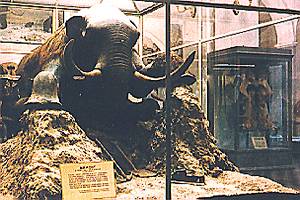
Here is a really shocking – to our previous way of thinking – picture. Vast herds of enormous, well-fed beasts not especially designed for extreme cold, placidly feeding in sunny pastures, delicately plucking flowering buttercups at a temperature in which we would probably not even have needed a coat. Suddenly they were all killed without any visible sign of violence and before they could so much as swallow a last mouthful of food, and then were quick-frozen so rapidly that every cell of their bodies is perfectly preserved, despite their great bulk and their high temperature. What, we may well ask, could possibly do this?
“Now, volcanoes, when in eruption, not only spew out lava and hurl out rocks but also eject masses of dust particles, steam and other gases. Some of the dust may be shot into the upper atmosphere and then drift all around the earth. … A sudden mass of extrusion of dust and gases would cause the formation of monstrous amounts of rain and snow, and it might even be so heavy as to cut out sunlight altogether for days, weeks, months, or even years if the crustal movements continued. Wind beyond anything known today would be whipped up, and cold fronts of vast lengths would build up with violent extremes of temperature on either side. Here would be forty days and nights of snow in one place, continent-wide floods in another, and roaring hurricanes, seaquakes and earthquakes bringing landslides and tidal waves in others, and many other disturbances. But perhaps more important may have been the gases which would probably have been shot up highest of all. What would have happened to them?
“And there is where we get back to quick-freezing mammoths, for the frozen-food experts have pointed out that to do this, starting with a healthy live specimen, you would have to drop the temperature of the air surrounding it down to a point of well below minus-150 degrees Fahrenheit (-101.1°C). There are two ways of freezing rapidly – one is by the blast method, the other by the mist process; these terms explain themselves. Moreover, the colder air or any gases become, the heavier it gets. If the volcanic gases went up far enough they would be violently chilled by the ‘cold of space,’ as it is called, and then as they spiraled toward the poles, as all the atmosphere in time does, they would begin to descend.
“When they came upon a warm layer of air, they would weigh heavily upon it and pull all the heat out of it and then would eventually fall through it, probably with increasing momentum and perhaps in great blobs, pouring down through the weakest spots. And if they did this, the blob would displace the air already there, outward in all directions and with the utmost violence. Such descending gases might well be cold enough to kill and then instantly freeze a mammoth.
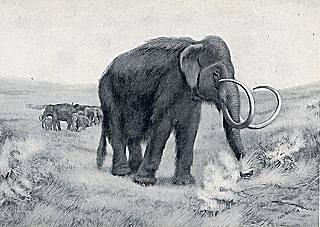
Consider now our poor mammoth placidly munching away in his meadow, perhaps even under a warm sun. The sky need not been clouded over, and here need not even be a dust of haze where he is living, which would appear to have been then about where Central Asia is today. All of a sudden, in a matter of minutes, the air begins to move in that peculiar way one may experience today at the end of the arctic summer when the first cold front descends and the temperature may drop sixty degrees (15.5°C) in an hour.
“All the mammoths feels is a sudden violent tingling all over his skin and a searing pain in his lungs; the air seems suddenly to have turned to fire. He takes a few breaths and expires, his lungs, throat, eyeballs, ears and outer skin already crystallized. If he is near the center of the blob, the terrible mist envelops him, and in a few hours he is a standing monument of what is virtually rock. Nor need there be any violence until the snow comes softly to pile up on him and bury him. And here we leave him for a moment and turn to his distant cousin chewing away in Alaska, just outside the area where the blob descends. What happens to him?
“The sky here probably does cloud over, and it may even start to snow, something he has not before encountered in September, when he is in the north on his summer migration. He starts to pad off for cover. But then comes a wind that rapidly grows and grows in fury and explodes into something unimaginable. He is lifted off his feet and, along with bison, lion, beaver from ponds, and fish from rivers, is hurled against trees and rocks, torn literally to bits and then bowled along to be finally flung into a seething caldron of water, mud, shattered trees, boulders, mangled grass and shrubbery and bits of his fellows and of other animals. Then comes the cold that freezes the whole lot, and finally, when the holocaust is over, the snow covers it all.
“This is exactly the state of affairs that we find in Alaska, where the mammoths and other animals, with one or two significant exceptions, were all literally torn to pieces while still fresh. Young and old alike were cast about, mangled and then frozen. There are also, however, other areas where the animals are mangled, but had time to decompose before they froze; and still others where they decomposed down to the bones and were then either frozen or not. Beyond these again, there are similar vast masses of animals, including whole families or herds, all piled together into gullies and riverbeds and other holes, but where only bones remain.

Here may be the answer to our riddle of why we find mammoths with buttercups in their teeth in one place, shredded but still-edible mammoths in another, rotting mammoths in a third, and mammoth boneyards somewhere else. The animals were frozen whole where the blobs of cold air descended before the wind began, shredded and frozen where the winds came before the cold had spread out, and reduced to bones where the animals had time to decompose before the cold reached them or the moving crust (of the earth) carried them north.
“The remains, if still sticking out of the ground where the middle of the blob occurred, would have been safely sealed in when the snow came, as the Berezovka mammoth probably was. This would seem to be additional proof, for a true ice-cap never formed in Siberia, because the crust was still shifting. There is evidence that one once started to grow there, but that it soon died away, and as it did so, vast floods of melt water brought great quantities of silt down from the south – which is the direction the rivers flow in Siberia – and deposited it upon the compacted snow. This froze in the fall, but melted in the spring, and since a dark material absorbs more heat, it gradually, year by year, dissolved the snow below and descended upon and eventually enveloped the quick-frozen mammoth by the slow substitution of chilled silt for compacted snow. Ivan T. Sanderson, 1960, Saturday Evening Post, “Riddle of the Frozen Giants.”
About Loren Coleman
Loren Coleman is one of the world’s leading cryptozoologists, some say “the” leading living cryptozoologist. Certainly, he is acknowledged as the current living American researcher and writer who has most popularized cryptozoology in the late 20th and early 21st centuries.
Starting his fieldwork and investigations in 1960, after traveling and trekking extensively in pursuit of cryptozoological mysteries, Coleman began writing to share his experiences in 1969. An honorary member of Ivan T. Sanderson’s Society for the Investigation of the Unexplained in the 1970s, Coleman has been bestowed with similar honorary memberships of the North Idaho College Cryptozoology Club in 1983, and in subsequent years, that of the British Columbia Scientific Cryptozoology Club, CryptoSafari International, and other international organizations. He was also a Life Member and Benefactor of the International Society of Cryptozoology (now-defunct).
Loren Coleman’s daily blog, as a member of the Cryptomundo Team, served as an ongoing avenue of communication for the ever-growing body of cryptozoo news from 2005 through 2013. He returned as an infrequent contributor beginning Halloween week of 2015.
Coleman is the founder in 2003, and current director of the International Cryptozoology Museum in Portland, Maine.
Filed under Breaking News, Cryptotourism, CryptoZoo News, Cryptozoologists, Cryptozoology, Evidence, Forensic Science, Fossil Finds